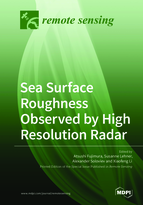Sea Surface Roughness Observed by High Resolution Radar
A special issue of Remote Sensing (ISSN 2072-4292). This special issue belongs to the section "Ocean Remote Sensing".
Deadline for manuscript submissions: closed (31 December 2018) | Viewed by 49542
Special Issue Editors
Interests: plankton ecology; harmful algal bloom; biogeochemistry; remote sensing; biophysical interactions; coastal oceanography; computational fluid dynamics; coral reef ecology
Special Issues, Collections and Topics in MDPI journals
Interests: ocean remote sensing; synthetic aperture radar; severe weather; tropical cyclones; ocean waves
Interests: near-surface of the ocean; hurricane physics; computational fluid dynamics; remote sensing; coastal ocean; circulation marine and environment engineering
Interests: AI oceanography; big data; ocean remote sensing; physical oceanography; boundary layer meteorology; synthetic aperture radar imaging mechanism; multiple-polarization radar applications; satellite image classification and segmentation
Special Issues, Collections and Topics in MDPI journals
Special Issue Information
Dear Colleagues,
We are happy to invite you to submit a paper to Remote Sensing for a Special Issue, “Sea Surface Roughness Observed by High Resolution Radar”, which cooperates with the 2018 Ocean Sciences Meeting (https://agu.confex.com/agu/os18/preliminaryview.cgi/Session28340).
Using various radar frequencies, resolutions, and modes of polarization, sea surface features have been analyzed by many research groups, bringing together very different datasets, thus allowing for new insights in small-scale processes at a larger areal coverage.
This Special Issue aims at investigating sea surface features detected by high spatial resolution radars, such as synthetic aperture radar (SAR). Such sea surface features include, but are not limited to: Upwelling, oceanic fronts, coastal processes on reefs, lee waves, swell, wind shadows, wind rolls, internal structures of tropical cyclones, oil seepage and natural slicks, internal waves, and turbulent effects due to wakes. We especially welcome studies on turbulent features at the air–sea interface at a resolution finer than 10 m, with a combination of remote sensing, in situ, and modeling techniques.
Thank you for your time and consideration.
Related References
-
Gebhardt, C.P.; Bidlot, J-R.; Gemmrich, J.; Lehner, S.; Pleskachevsky, A.; Rosenthal, W. Wave observation in the marginal ice zone with the TerraSAR-X satellite. Ocean Dyna. 2016, 66, 839–852.
-
Pleskachevsky, A.; Rosenthal, W.; Lehner, S. Meteo-marine parameters for highly variable environment in coastal regions from satellite radar images. ISPRS J. Photo. Remote Sens. 2016, 119, 464–484.
-
Ressel, R.; Frost, A.; Lehner, S. A neural network based classification for sea ice types on X-Band SAR images. IEEE J. Sel. Top. Appl. Earth Obs. Remote Sens. 2015, 8, 3672–3680.
-
Lehner, S.; Pleskachevsky, A.; Bruck M. High resolution satellite measurements of coastal wind field and sea state. Int. J. Remote Sens. 2012, 33, 7337–7360.
-
Lehner, S.; Schulz-Stellenifleth, J.; Schättler, B.; Breit, H.; Horstmann, J. Wind and wave measurements using complex ERS-2 SAR wave mode data. IEEE Trans. Geosci. Remote Sens. 2000, 38, 2246–2257.
-
Lehner, S.; Horstmann, J.; Koch, W.; Rosenthal, W. Mesoscale wind measurements using recalibrated ERS SAR images. J. Geophys. Res. Oceans. 1998, 103, 7847–7856.
Dr. Atsushi Fujimura
Dr. Susanne Lehner
Dr. Alex Soloviev
Dr. Xiaofeng Li
Guest Editors
Manuscript Submission Information
Manuscripts should be submitted online at www.mdpi.com by registering and logging in to this website. Once you are registered, click here to go to the submission form. Manuscripts can be submitted until the deadline. All submissions that pass pre-check are peer-reviewed. Accepted papers will be published continuously in the journal (as soon as accepted) and will be listed together on the special issue website. Research articles, review articles as well as short communications are invited. For planned papers, a title and short abstract (about 100 words) can be sent to the Editorial Office for announcement on this website.
Submitted manuscripts should not have been published previously, nor be under consideration for publication elsewhere (except conference proceedings papers). All manuscripts are thoroughly refereed through a single-blind peer-review process. A guide for authors and other relevant information for submission of manuscripts is available on the Instructions for Authors page. Remote Sensing is an international peer-reviewed open access semimonthly journal published by MDPI.
Please visit the Instructions for Authors page before submitting a manuscript. The Article Processing Charge (APC) for publication in this open access journal is 2700 CHF (Swiss Francs). Submitted papers should be well formatted and use good English. Authors may use MDPI's English editing service prior to publication or during author revisions.
Keywords
- Radar
- Sea surface roughness
- Air-sea interaction
- SAR






